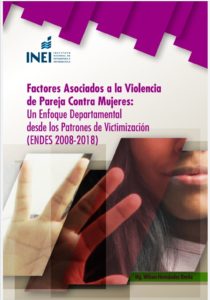Factores asociados a la violencia de pareja contra mujeres: un enfoque departamental desde los patrones de victimización (ENDES 2008-2018)
| Year | : | 2019 |
|---|---|---|
| Author/s | : | Wilson Hernández |
| Area/s | : | Ethnicity, gender and citizenship |
Hernández, W. (2019). Factores asociados a la violencia de pareja contra mujeres: un enfoque departamental desde los patrones de victimización (ENDES 2008-2018). Lima: INEI.
In Peru, violence against women is a problem of high and persistent prevalence. Despite this, little has been studied in the country and precisely due to two central limitations. On the one hand, research has used aggregated measures contributing to the image of a homogeneous profile’s victim that do not represent the subgroups of women who are subject to different severity, frequency and temporality of violence. On the other hand, the analysis at national level has been privileged, leaving behind sub natio- nal analysis. Based on the work of Hernández and Morales (2019), this study is the first contribution to cover both gaps. The first objective was to identify different victimization patterns based on the severity, frequency and temporality of violence in each department, and then estimate the risk factors associated with violence (physical and / or sexual) against women in the past twelve months. The findings reveal that there are four different victimization patterns among departments, one of which is divided into high or low intensity. However, the proportion of women in each pattern varies significantly by department, su- ggesting the existence of social and cultural factors that may influence their lower or higher prevalence. The analysis of risk factors of pattern of victimization by department offers abundant new evidence that allows for further analysis at the sub national level. The findings highlight the relevance of the history of sexual violence ever suffered as the most important predictor of recent physical and / or sexual violence. Frequent alcohol consumption is also gradually associated with this form of violence (the greater the violence in the pattern of victimization, the effect tends to be higher). The study ends with some policy recommendations based on strong international evidence on how to reduce violence against women.







